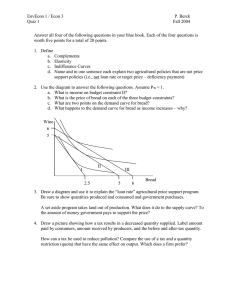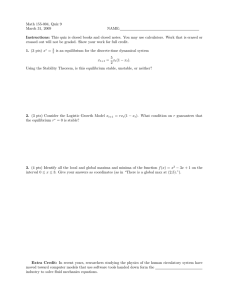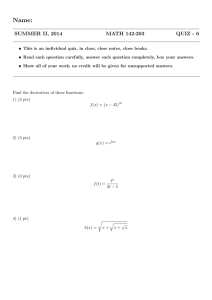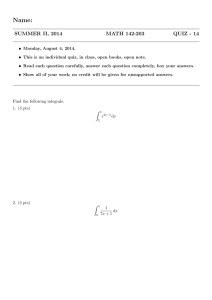Answer to Exam I 04
advertisement
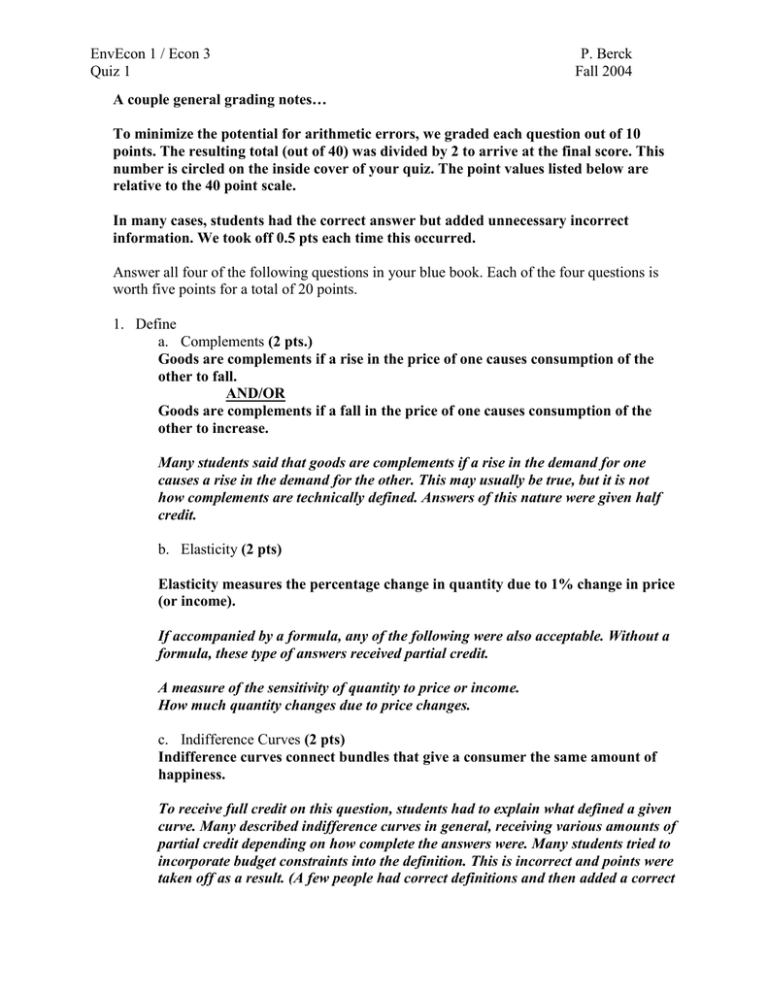
EnvEcon 1 / Econ 3 Quiz 1 P. Berck Fall 2004 A couple general grading notes… To minimize the potential for arithmetic errors, we graded each question out of 10 points. The resulting total (out of 40) was divided by 2 to arrive at the final score. This number is circled on the inside cover of your quiz. The point values listed below are relative to the 40 point scale. In many cases, students had the correct answer but added unnecessary incorrect information. We took off 0.5 pts each time this occurred. Answer all four of the following questions in your blue book. Each of the four questions is worth five points for a total of 20 points. 1. Define a. Complements (2 pts.) Goods are complements if a rise in the price of one causes consumption of the other to fall. AND/OR Goods are complements if a fall in the price of one causes consumption of the other to increase. Many students said that goods are complements if a rise in the demand for one causes a rise in the demand for the other. This may usually be true, but it is not how complements are technically defined. Answers of this nature were given half credit. b. Elasticity (2 pts) Elasticity measures the percentage change in quantity due to 1% change in price (or income). If accompanied by a formula, any of the following were also acceptable. Without a formula, these type of answers received partial credit. A measure of the sensitivity of quantity to price or income. How much quantity changes due to price changes. c. Indifference Curves (2 pts) Indifference curves connect bundles that give a consumer the same amount of happiness. To receive full credit on this question, students had to explain what defined a given curve. Many described indifference curves in general, receiving various amounts of partial credit depending on how complete the answers were. Many students tried to incorporate budget constraints into the definition. This is incorrect and points were taken off as a result. (A few people had correct definitions and then added a correct EnvEcon 1 / Econ 3 Quiz 1 P. Berck Fall 2004 statement about the relationship between indifference curves and budget constraints. This was unnecessary, but if all the statements were correct, full credit was still given.) d. Name and in one sentence each explain two agricultural policies that are not price support policies (i.e., not loan rate or target price – deficiency payment) (2 pts per policy) To receive credit, students had to describe two policies discussed in class. Points were taken off if policies were identified incorrectly or only barely described. 2. (10pts) Use the diagram to answer the following questions. Assume PW = 1. a. What is income on budget constraint II? (2pt) Y=Pw*5 =5 b. What is the price of bread on each of the three budget constraints? (4pts) First, find out the y associated with each BC For BCI and BCII, y=5*Pw=5 For BCIII, y=6*Pw=6 Second, get the price: formula and plugging in right numbers. Pb1=5/2.5=2 Pb2=5/5=1 Pb3=6/6=1 Correct results---1pt. c. What are two points on the demand curve for bread? --------------(2pt) The two tangency points on I and II. Need clear labels to get the point. 1pt for each point. If draw a demand curve with with the coordinates (Pb,B) be (2,1.5) and (1,2) are also good. d. What happens to the demand curve for bread as income increases – why? Wine 6 5 II I 2.5 III 5 6 Bread EnvEcon 1 / Econ 3 Quiz 1 P. Berck Fall 2004 The demand curve shifts in as income increases. Because the chosen bundle on a higher budget constraint with the same price of bread (demonstrated by the slope of BC II and BCIII) contains less bread. ----If the answer “shifts in” but gave the wrong reason, then no credit would be granted. Can say “because bread is an inferior good”, the inferiority is the consequence of the shift, not the cause. 3. Draw a diagram and use it to explain the “loan rate” agricultural price support program. Be sure to show quantities produced and consumed and government purchases. (3.5pts) PL Gov’t Purchases QD QS In the loan rate program, the government effectively sets the price of the commodity at PL. This induces farmers to produce QS. At the price of PL, consumers purchase only QD . Therefore to support the price, the government must purchase the quantity QS - QD. A correct diagram with clear labels and no explanation was given 6/7. The question asked you to draw a diagram and use it to explain the loan rate policy, so some sort of explanation was necessary. Grading: Drawing PL above the original equilibrium – 1 pt QS – 2 pt QD – 2 pt Gov’t purchases – 2 pt Many students confused the loan rate and target price/deficiency payment policies or tried to combine them in one picture. Usually these answers had the price floor drawn correctly and identified quantity supplied and therefore received 3 pts. A set aside program takes land out of production. What does it do to the supply curve? To the amount of money government pays to support the price? Explain your answer in a few sentences. (3 pts) EnvEcon 1 / Econ 3 Quiz 1 P. Berck Fall 2004 S’ S PL QD QS’ QS The program causes the supply curve to shift inward, therefore reducing the amount of the commodity produced at the price PL . Since the demand curve is unaffected, there is less excess for the government to purchase. The amount the government spends to support the price is reduced from the entire shaded region to only the diagonally shaded region. Diagrams were not necessary. Grading: Supply shifts inward – 1 pt Government expenditures fall – 1 pt Including some type of correct explanation – 1 pt A lot of people said that consumers would be paying more due to the reduction in supply. As you can see from the diagram, this is not necessarily true. In fact, it only happens if farmers take so much land out of production that the price floor is no longer binding. We took off 1 pt for saying this unless you noted that either the gov’t doesn’t have to support the price anymore or that the price floor is no longer binding. Also, many people did not connect the government expenditures to purchasing the excess with the loan rate, but instead talked about the amount the government spends on the set aside policy. These answers were incorrect because the set aside is not a price support policy and hence the expenditures students referred to were not expenditures to support the price. Moreover, the set aside policy was discussed in class as a policy designed to do exactly what is shown in the picture. 4. (10 pts) Draw a picture showing how a tax results in a decreased quantity supplied. For the after tax equilibrium, label price paid by consumers and price received by producers. Show the before and after-tax quantity. (This part---5pts) EnvEcon 1 / Econ 3 Quiz 1 P. Berck Fall 2004 P S Pd Pnt Ps D t Dt Qt Qnt Notation: D is the original demand curve. Dt is the after-tax demand curve from a producer’s point of view. Pnt is the before-tax equilibrium price while Qnt is the corresponding before tax equilibrium quantity. Pd is the price paid by consumers and Ps is the price received by suppliers. Qt is the after-tax equilibrium quantity. Correct diagram----meaning correct slope of D and S curves, the orientation of axis, and an inward shift of the D curve to demonstrate the tax effect ---gets 1 point. Alternatively, could illustrate the tax with an inward shift of S curve. Correct labeling of Pd, Ps, Qnt, and Qt gets 1 pts each. How can a tax be used to reduce pollution? (1pt) Compare the use of a tax and a quantity restriction (quota) that have the same effect on output (diagram—1pt, explanation-1pt). Which does a firm prefer? Why? (1 pt for each if correct reason is given , but none if reason is wrong.) When output is positively related with total pollution, an imposition of tax will result in a reduction in output produced as shown in the above diagram. A tax leads to either an increase in consumer’s price or an increase in the producer’s cost (or both), therefore reducing equilibrium quantity. (1pts. As long as referring to the diagram you drew and talk about reduction in equilibrium quantity it is fine.) For comparison between quota and tax, please see the diagram below. If one can draw a diagram, then she gets 2 pts. Alternatively, one can answer verbally the effects of both in terms of the equilibrium price and quantity. The main point is that with a quota, the equilibrium price, which is also the price received by the producers, is equal to the price paid by consumer. And from the diagram we know EnvEcon 1 / Econ 3 Quiz 1 P. Berck Fall 2004 that in the case of tax, the price received by the producers is t below price paid by the consumers. Therefore, a producer would prefer a quota instead of a tax because he’s selling same amount of output with a higher price. EnvEcon 1 / Econ 3 Quiz 1 P. Berck Fall 2004 P S Pd Ps D Dt Q=Qt Q
